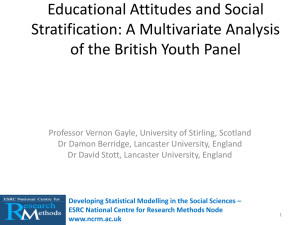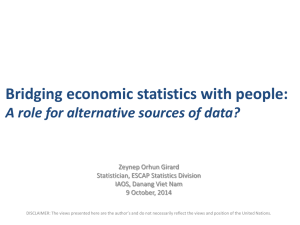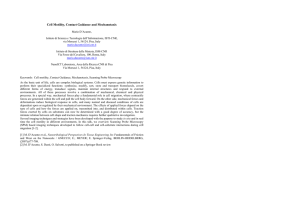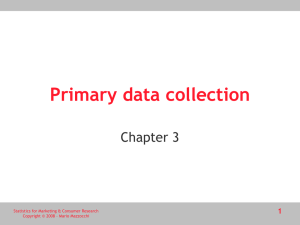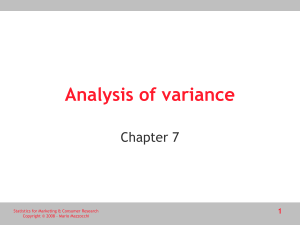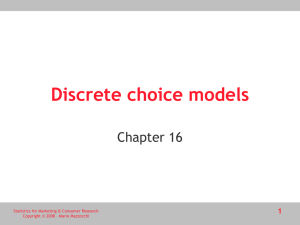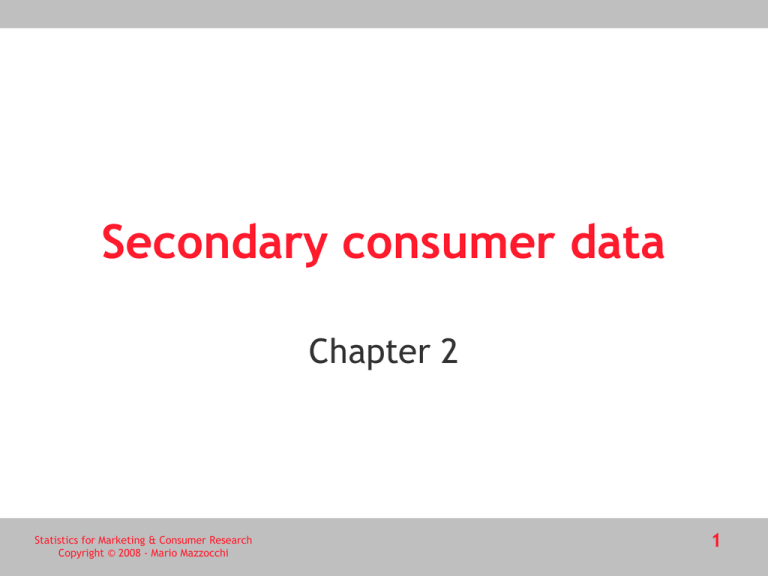
Secondary consumer data
Chapter 2
Statistics for Marketing & Consumer Research
Copyright © 2008 - Mario Mazzocchi
1
Primary vs.secondary data
Primary data: data directly collected for the purposes of
the research under the researcher"s control
Secondary data: exploitation of data already available
which is useful to the research aims although not being
explicitly built for its scopes
Statistics for Marketing & Consumer Research
Copyright © 2008 - Mario Mazzocchi
2
Using secondary data
A checklist:
1.
Is primary data collection too expensive or time consuming compared
to secondary data?
2.
Is there information about the quality of secondary data (survey
method, questionnaire if relevant, etc.)?
3.
Is the sample probabilistic and the sampling method known?
4.
Does the target population of the secondary data sources coincide
with the research target population?
5.
Are secondary data outdated?
6.
Is the source of secondary data independent and free from biases?
7.
Does the purpose of secondary data fit with those of the research?
8.
Is there any risk that some key variable is missing from secondary
data?
9.
Is it possible to make time comparisons with secondary data?
10. Are micro-data available?
Statistics for Marketing & Consumer Research
Copyright © 2008 - Mario Mazzocchi
3
Costs and timing issues
• Some secondary data are prohibitively expensive to a level
that primary data collection might be convenient
• Even when costs for primary data collection are slightly
higher, an ad-hoc survey gives more control and is
preferable
• Secondary data collection is also preferred when a very
quick response is needed and there is no time for a proper
data collection step
• In some circumstance, even when secondary data have
quality limitations, research findings accompanied by a
transparent discussion of data issue and an effort for error
quantification can be a satisfactory alternative
Statistics for Marketing & Consumer Research
Copyright © 2008 - Mario Mazzocchi
4
Information on data quality
• Secondary data should be accompanied with detailed
information on the sampling plan, questionnaire, interview
methods, non-response treatments, etc.
• A critical review of secondary data construction may lead
to two outcomes:
(a) data are of an acceptable quality hence statistical processing will
be meaningful;
(b) quality is inadequate because of serious shortcomings
• Even in case (b) the review proves very useful: the
necessary primary research can now be set up exploiting
strengths and fixing weaknesses of the secondary source.
Statistics for Marketing & Consumer Research
Copyright © 2008 - Mario Mazzocchi
5
Sampling technique
• As discussed in lecture five (Sampling), inference
on sample data is only possible when the sample is
extracted through probabilistic rules
• Non-probabilistic samples (such as quota sampling
or haphazard samples) might be biased and
misleading
• When using secondary data, a necessary condition
is to be informed on the sampling method and on
the steps taken to ensure sample
representativeness.
Statistics for Marketing & Consumer Research
Copyright © 2008 - Mario Mazzocchi
6
Target populations
• Representativeness is the extent to which observations in a
sample reflect the key (targeted) characteristics of the
population
• When relying on secondary data, it is necessary to check that the
sample is also representative for our target population
• Even with probabilistic methods, representativeness is a relative
concept, usually based on one or a few variables
• Example of misuse of secondary data:
Survey data on purchasing for a wide basket of goods – one is
interested in fizzy drinks consumption and these are part of the
basket
Even with a geographically representative sample and adequate data
quality, suppose the data collection step has been carried out in
July: one gets an upward biased estimate of consumption, because
the target population of the secondary data (consumers in July)
does not fit adequately with our target population (fizzy drinks
consumers throughout the year)
Statistics for Marketing & Consumer Research
Copyright © 2008 - Mario Mazzocchi
7
Time lags
• A key question: could the time lag between the
current research and the data collection step pose
problems?
• The relevance of the time lag depends on the
research objectives.
If the aim is to explore whether there is room for a novel
product, it may be very risky to rely on outdated
information
If the research purpose is to explore a relationship
between two or more variables which can be safely
assumed to be stable in the medium term (like income
elasticities), then a time lag of a couple of years may be
acceptable
Statistics for Marketing & Consumer Research
Copyright © 2008 - Mario Mazzocchi
8
Source reliability
• It is not infrequent to have very different
measurements for the same variable,
according to the source – especially for
sensitive data
• Example – electoral surveys
• Meta-analyses of secondary data allow
evaluations of source reliability
Statistics for Marketing & Consumer Research
Copyright © 2008 - Mario Mazzocchi
9
Meta-analysis
• Meta-analysis is the statistical analysis of several research findings. Its aim is to
combine the results of several studies to gain broader knowledge of a
phenomenon
• Simple meta-analysis – averaging measures of a given variable across different
studies.
• More complex meta-analysis – relate the target effect (the target/dependent
variable) on the characteristic of the research environment of the selected
studies (the explanatory variables). This allows one:
(a)To gather useful information on the direction of the relationship; and
(b)To identify potential biases in research designs and sources.
• The contribution of meta-analysis depends on the number of studies taken into
account and is based on a rigorous and systematic selection and classification of
the meta-data
• Drawback of meta-analysis – the sources of bias are difficult to be controlled. If
it is an indicator of the methodological quality of the study, then the effect of
improper methods can be evaluated. Otherwise, improper studies may reflect
on the final estimates of meta-analysis.
• The method is increasingly used in marketing and consumer research.
Statistics for Marketing & Consumer Research
Copyright © 2008 - Mario Mazzocchi
10
Purpose of secondary data collection
• Before using secondary data, one should consider the purpose of its
collection
• Example –
• Household food expenditure data, collected by on official source as
part of a budget survey within the national accounting system
• This current research: evaluate food consumption and nutrition
intakes
• Problem: expenditures depend on price levels and the sample could
be representative in terms of the range of price levels faced by the
population, while food consumption may depend on a number of
lifestyle variables not necessarily accounted for in designing the
expenditure survey.
• While the above source of bias is likely to influence the results and
needs to be carefully addresses, it is not necessarily a reason for
abandoning the analysis of secondary data
Statistics for Marketing & Consumer Research
Copyright © 2008 - Mario Mazzocchi
11
Completeness of the secondary data
• Are all the necessary variables considered in the target
data set?
• Example – Food consumption data can be estimated
through:
(a) respondent statements on consumption (e.g. food intake survey)
(b) purchase data divided by price data (e.g. household budget survey)
(c) disappearance data (e.g. production-export+import)
(d) supermarket scan data
• Scan data excludes those shoppers who shop at local stores
rather than supermarkets
• Purchase and disappearance data also include quantities
that are not consumed or wasted within the household
Statistics for Marketing & Consumer Research
Copyright © 2008 - Mario Mazzocchi
12
Availability of data observed at several
points in time
• When secondary data are collected at regular
intervals – sometimes even on the same individuals
– they allow for the evaluation of dynamic
behaviours
• Panel data is made by variables observed on the
same units at several points in time
• Repeated surveys are extremely expensive and
consistency across surveys is not easy to be
guaranteed; in this case secondary sources have a
key advantage on running an expensive primary
panel survey.
Statistics for Marketing & Consumer Research
Copyright © 2008 - Mario Mazzocchi
13
Household budget surveys (3)
Drawbacks
(a) some respondent biases (especially in diary keeping)
(b) (frequent) chaselack of information on prices and
quantities
(c) delay between data collection and data publication (at
least one or two years)
(d) usually lack information on attitudes or point of
purchase
Statistics for Marketing & Consumer Research
Copyright © 2008 - Mario Mazzocchi
14
Micro-data
• Secondary data can be provided at different levels
of aggregation
• Micro-data i.e. individual information on each of
the sampled units, is increasingly available
• Availability of individual (micro) data helps to
correct sampling biases or target population mismatches, besides allowing to take into account as
many control factors as the number of variables
available for each statistical unit
• The availability of micro-data is a big incentive to
the use of secondary data
Statistics for Marketing & Consumer Research
Copyright © 2008 - Mario Mazzocchi
15
A rough guide to secondary data
sources for consumer research
1.
2.
3.
4.
5.
Household surveys
Lifestyle and social trend surveys
Consumer panels
Attitude surveys
Retail level surveys
Statistics for Marketing & Consumer Research
Copyright © 2008 - Mario Mazzocchi
16
Household budget surveys (1)
• Main purpose – to gather data on household expenditures
• Nationally representative samples, usually sampling designs
allow for representativeness of population sub-groups (e.g.
regions, age groups, etc.)
• Data collection based on weekly or bi-weekly diaries where
expenditures are recorded (in some cases receipts are
collected) and final questionnaire (with sociodemographics)
Statistics for Marketing & Consumer Research
Copyright © 2008 - Mario Mazzocchi
17
Household budget surveys(2)
Advantages
a) based on large and representative samples
b) allow to explore relation between expenditures and a
set of household information
c) carried out at regular intervals
d) generally accessible at a very low cost, often for free
e) Individual household data (treated to guarantee
anonymity) is usually available, allowing for a high
degree of personalization in cross-tabulation and
processing
Statistics for Marketing & Consumer Research
Copyright © 2008 - Mario Mazzocchi
18
Household surveys in the UK
• UK Expenditure and Food Survey
• Merger of National Food Survey and the Household Expenditure
Survey
• About 7,000 British households
• face-to-face interviews and bi-weekly diary on daily expenditures
for household members greater than sixteen
• Harmonization with EU surveys through a common classification of
individual consumption by purpose (COICOP).
• Two questionnaires: information on one-time purchases and
information about the income of each adult member of the
household
• Other household surveys:
• Family Resource Survey (tenure and housing costs)
• National Diet and Nutrition Survey (every four to five years to
monitor food consumption and dietary habits through a seven day
dietary record).
Statistics for Marketing & Consumer Research
Copyright © 2008 - Mario Mazzocchi
19
The US consumer survey
• United States Consumer Expenditure Survey (CES)
•
•
Managed by the Bureau of Labor Statistics
Two separate and independent samples:
• Computer-assisted interviews
• diary filled by the household members
•
•
•
•
•
Household income and socio-economic characteristics are in
common
Data are publicly available and date back to 1980
About 7,500 households enter each of the surveys.
Interview survey: monthly out-of-pocket expenditures such as
housing, apparel, transportation, health care, insurance, and
entertainment
Diary survey: weekly expenditure of frequently purchased items
such as food and beverages, tobacco, personal care products, and
non-prescription drugs and supplies.
Statistics for Marketing & Consumer Research
Copyright © 2008 - Mario Mazzocchi
20
Household budget surveys in Europe
• Each EU member state conducts
its own household budget survey
• Since 1988 the European
Statistical Institute (Eurostat)
has started a harmonization
effort
• EU household budget survey
every five or six years which
consists in the ex-post
harmonization of National microdata
• Aggregate data are available on
the Eurostat New-Cronos Data
Bank, with average expenditure
by country and COICOP category.
Statistics for Marketing & Consumer Research
Copyright © 2008 - Mario Mazzocchi
Household Budget Surveys in the European Union (EU-15)
Enquête sur les Budgets des Ménages
Forbrugerundersøgelsen
Einkommens- und Verbrauchsstichprobe
Family Budget Survey
Encuesta Continua de Presupuestos Familiares
Encuesta Basica de Presupuestos Familiares
Enquête Budgets des Familles
France:
Household Budget Survey
Ireland:
Rilevazione sui consumi delle famiglie italiane
Italy:
Luxembourg: Enquête Budgets Familiaux
Netherlands: Budgetonderzoek
Konsumerhebung
Austria:
Inquérito aos orçamentos familiares
Portugal:
Kulutustukimus
Finland:
Hushållens utgifter
Sweden:
Expenditure and Food Survey
UK:
Belgium:
Denmark:
Germany:
Greece:
Spain:
21
The COICOP classification
Example:
3 CLOTHING AND FOOTWEAR
3.1 Clothing
3.1.1 Garments
3.1.1.1 Men"s outerwear
3.1.1.2 Women"s outerwear
3.1.1.3 Children"s outerwear
3.1.1.4 Other garments
3.1.2/3 Other articles of clothing and clothing accessories and cleaning,
repair and hire of clothing
3.2 Footwear
3.2.1/2 Shoes and other footwear and repair and hire of footwear
CLICK HERE FOR THE COMPLETE CLASSIFICATION
Statistics for Marketing & Consumer Research
Copyright © 2008 - Mario Mazzocchi
22
Lifestyle and social trend surveys
• Main purpose: to record a wide range of variables
focusing on social dynamics, habits and lifestyle
trends
• These surveys are multi-purpose with some
sections that remain unchanged over time to allow
for comparisons, other sections that change
cyclically so that time comparisons are still
possible although not on a yearly basis, and some
sections change every year to look into specific
issues of current relevance
Statistics for Marketing & Consumer Research
Copyright © 2008 - Mario Mazzocchi
23
Multi-purpose surveys in the UK
• General household survey
•
•
•
•
•
household as the sample unit, but information collected on individuals
approximately 9,000 households – about 16,000 adults aged sixteen and over
Data on education, employment, health, housing, and population and family
information
Other areas covered periodically (e.g. leisure, household burglary, smoking and
drinking)
Face-to-face computer assisted interviews and some self-completion sections.
• Office for National Statistics (ONS) omnibus survey
•
•
about 1,800 adults are interviewed by Computer-aided personal interviewing
large range of topics, such as contraception, unused medicines, tobacco
consumption, changes to family income, internet access, arts participation,
transport, fire safety and time use
• Other surveys
•
•
•
Smoking, drinking and drug use among young people survey
Time use survey on lifestyles
National Surveys of Sexual Attitudes and Lifestyles (sexual habits of British people)
• About 6,400 respondents
• Household questionnaire, individual questionnaire and self-completion 24-hour
diaries (10-minute slots) Topics covered include employment, qualifications,
leisure time activities and demographic details
Statistics for Marketing & Consumer Research
Copyright © 2008 - Mario Mazzocchi
24
Consumer panels
• Objective: monitor consumption dynamics or
response to changing factors (like
advertising)
• Repeated surveys where the same
individuals are interviewed over time
• Panel surveys have higher response rates,
but are very expensive, so access to
secondary data is generally preferred
Statistics for Marketing & Consumer Research
Copyright © 2008 - Mario Mazzocchi
25
British household panel survey
• ONS British household panel survey
• monitors social and economic change at the individual
and household level in Britain
• Data: a range of socio-economic variables (housing,
neighbourhood, demographics, residential mobility,
health and caring, employment and earnings, lifetime
childbirth, marital and relationship history, employment
status history, values and opinions, household finances
and organization)
• Annual survey of adults – 5,000 households (about
10,000 individuals).
Statistics for Marketing & Consumer Research
Copyright © 2008 - Mario Mazzocchi
26
European panel survey
• Launched in 2005 by Eurostat
• EU-wide household panel survey, named European Union Statistics on
Income and Living Conditions, EU-SILC
• Every year the survey collects micro-data on income, poverty, social
exclusion, labour, education, health information and living conditions in
all twenty-five member states plus Norway and Iceland
• Will include Turkey, Romania, Bulgaria and Switzerland in coming
years.
• Cross-sectional data on income, poverty, social exclusion and other
living conditions
• Longitudinal data to detect individual-level changes, referring to a four
year period
• EU-SILC is the evolution of the previous panel survey ECHP (European
Community Household Panel) run between 1994 and 2001
Statistics for Marketing & Consumer Research
Copyright © 2008 - Mario Mazzocchi
27
Attitudes and values
• Regular and official surveys do not usually provide a
sufficient detail.
• British social attitudes survey
• series of annual surveys to monitor dynamics in British social,
economic, political and moral values
• Around 3,600 individuals per year to answer
• some questions are the same throughout the years, others have a
lower frequency
• Large range of issues – newspaper readership, political parties and
trust, public spending,welfare benefits, health care, childcare,
poverty, the labour market and the workplace, education,
charitable giving, the countryside, transport and the environment,
Europe, economic prospects, race, religion, civil liberties,
immigration, sentencing and prisons, fear of crime and the portrayal
of sex and violence in the media.
Statistics for Marketing & Consumer Research
Copyright © 2008 - Mario Mazzocchi
28
Retail surveys
• Data collection at the point of purchase
• Usually scan tracking at the retail level
• Retail Sales Inquiry
• monthly collects sales data on 5,000 retailers
• all retailers with more than 100 employees plus stratified sample of
smaller retailer.
• records total retail turnover (including sales from stores, ecommerce, Internet sales, etc.), which is the value of sales of
goods to the general public for personal or household use
• Sales volume is also recorded following the COICOP classification
• Retail tracking services based on scan data are also
provided by Gfk, ACNielsen and IRI
Statistics for Marketing & Consumer Research
Copyright © 2008 - Mario Mazzocchi
29
Consumer trends
• UK Statistical Office (HMSO) time series data, which includes:
(a) quarterly data on household final consumption expenditure (from National Accounts)
according to the COICOP international classification
(b) monthly consumer and retail price indices;
(c) monthly data on consumer credit and other household borrowings
(d) monthly retail sales indices for different types of retailers and goods
• Consumer trends :
a) details on Household Final Consumption Expenditure (HHFCE) at aggregate level for
the whole UK on a quarterly basis
b) quarterly time series from 1963 to the latest information for each COICOP item
c) national expenditure (by UK citizens) and domestic expenditure (on UK territory)
d) raw (not seasonally adjusted) and seasonally adjusted data (where seasonal factors
have been removed through statistical methods)
e) current prices and constant prices, where the latter implies that expenditures have
been deflated so that the whole time series refer to the prices of a given base year
Statistics for Marketing & Consumer Research
Copyright © 2008 - Mario Mazzocchi
30
Commercial data
•
ACNielsen consumer panel (from 1989)
•
•
•
•
•
•
•
GfK retail panel in the UK
•
•
•
scanner-based supermarket tracking system with information on sales, market shares, distribution,
pricing and promotion, across retail channels
Data provided on a weekly basis in the week following the collection.
Taylor-Nelson Sofres (TNS) continuous household panel
•
•
•
more than 200 products monitored on retail outlets plus quarterly consumer panel of 18,000
households (HomeAudit)
Information Resources (IRI) InfoScan (from 1987)
•
•
home scanning technology (HomeScan™), of purchased products taken at home
all information on the barcode is memorized
Integration of scan data and traditional diaries
barcode scanners (MyScan™) for out-of-home purchases.
Nationally representative data which can be disaggregated by outlet type and by demographic group.
About 10,000 UK households plus the same methodology in twenty-six countries (210,000 households)
diaries and home scanners for fast moving consumer goods (FMCG) plus separate panel targeted at
individuals rather than household sfor goods like toiletries, textiles, impulse products, tobacco,
telecoms, fast food, petrol
TNS also records separately media audience,providing data for assessing advertising campaigns.
Ipsos Omnibus Surveys
•
•
•
•
regular surveys sponsored by multiple clients on the same sample
one section is stable over time, other sections are based on the information required by the clients.
In the UK, Ipsos runs regularly a survey on 2,000 households (Capibus™) with CAPI interviews
CATI alternative (Express™) and a web-based version (i:omnibus™) are also provided
Statistics for Marketing & Consumer Research
Copyright © 2008 - Mario Mazzocchi
31







